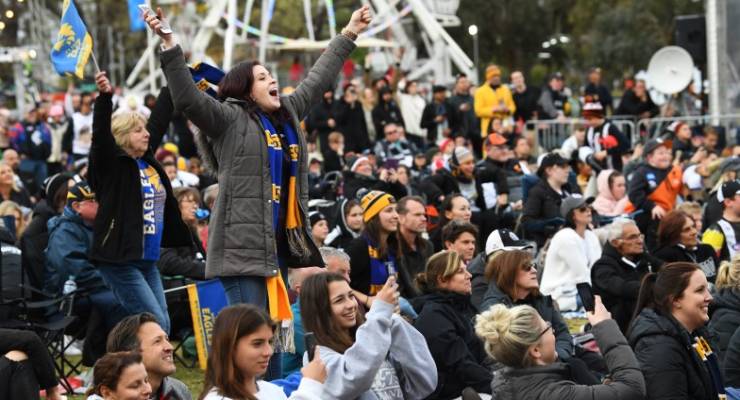
I have a confession to make: I’m an AFL trade-period addict. During the 10-day period, which closed last night, I drive to the sound of trade radio, and keep a tab open on every work-related browser for a live blog of the action (or inaction as the case may be). As a Western Bulldogs fan, I’ll admit to seeking daily updates on our never-ending quest to land a name like Chad Wingard before a richer, more successful club swoops in (see: Hawthorn). This addiction of mine is shared by many though it wasn’t always the case. Trade week has grown like weeds in recent years: but how and why?
The rise of player movements
Player movement has been part of the AFL landscape from its very beginnings. Even exalted names like Roy Cazaly (1921) and Ron Barassi (1965) switched clubs, the latter shocking the football community by departing Melbourne for the Blues. But, thanks partly to the introduction of free agency at the end of the 2012 season, speculation about player movement has reached the point of media saturation.
In recent years, Dustin Martin, Patrick Dangerfield and Lance Franklin have all played seasons under unrelenting contract scrutiny, while the sheer weight of analysis of potential player movements has grown exponentially over the last decade.
Launched in 2010, AFL trade radio now has its own set of sponsors and runs daily from 7am-7pm (with some segments now also streamed with video footage). In 2016, it had close to half a million engagements across Facebook and Twitter, and a 39% increase in audience year-on-year, which explains commercial interest. Live blogs now also dominate the mainstream sports media landscape, with News Corp, Fairfax, Fox Sports and the AFL website running unique offerings, albeit all with the same combination of speculation, one-eyed fan proposals (“I think they should give us Dylan Shiel for pick 68”) and blatant untruths.
The “fake news” factor
While hypotheticals have always been part of trade period, the prominence of social media has also enabled the rise of a range of unauthorised accounts professing to be privy to behind the scenes information, and making their own trade “announcements”. In September, for example, Facebook and Twitter account The AFL Update (which calls itself a “news and media website”) sent fellow Bulldog fans into meltdown when it “revealed” that Mitch Wallis had been signed by the Brisbane Lions. With Wallis shortly confirming that he was, in fact, staying at the Bulldogs, the account was forced to issue an apology for taking “strong reports” as gospel — the original post was also deleted.
The proliferation of these sporting “news” accounts may imbue fans with a healthy dose of scepticism, but they also further their appetite for updates on the arrival of their club’s next messiah (or the departure of a favourite son).
Why the hype?
The AFL, for what it’s worth, revels in this process, and has no intention to wind back the trade and draft periods and the hype they generate within the media. Despite clubs (and many fans) this year asking the AFL to cut the 11-day trade period down to eight, for example, the 2018 period has only been shortened to 10, with the deadline extended from the usual 2pm timeslot to the prime-time spot on 8.30pm last night.
As the 2018 period has illustrated, the length of the period often proves irrelevant in terms of deals done; most clubs will spend the vast majority of the period posturing, and waiting for the other party to blink.
Following the NFL
In many ways, the growing intrigue around trade period is a result of the AFL’s pursuit of the American model of draft and trading as exemplified by the National Football League in the US. This year, for example, the AFL has introduced NFL-style live trading of draft picks for the first time — meaning that clubs can trade both this year’s and future draft picks during the player draft in November, which has itself been extended to two days. The draft period includes a televised first round on 22 November, with the rest of the draft, and rookie draft, happening on the 23rd.
Such exposure for the draft and trade periods is in keeping with the “festival-like” atmosphere of the NFL draft, which was this year held in a stadium with a capacity of 80,000. Telecast coverage of the first round resulted in total viewership numbers of 11.2 million while many more followed updates online and on social media.
The AFL may not yet have generated the same hype as the NFL draft, but in keeping us all hooked on the ins and outs of trade period, it aspires to the same levels of attention. After all, in a competition of 18 teams and a premiership for only one, 17 clubs will go into 2019 having “failed” in their ultimate quest. Trade hysteria taps into the hopes of fans from those 17 teams.








Zero comments !
It seems few share your passion for what is essentially sports gossip Kate, myself included.
But at least your now on the board.
😉
I do wonder whether a big motivating factor is the AFL’s desire to be a year-long sporting brand. Having eclipsed rugby league as the nation’s winter code, it’s now keen to take over cricket and soccer during the warmer months. Compelling product like this – and AFLW – is the way to do it.